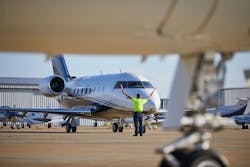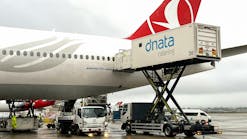Don’t Sleep On the Dangers of Fatigue
Aviation is an industry fraught with the potential for danger. It’s plain to those working on the ramp just what can go wrong.
Yet, sometimes the first steps leading up to an accident don’t take place on the ramp at all, but in bed – or more aptly – out of it.
Sleep deprivation and fatigue are easy to shrug off, with burning the midnight oil often being boasted about. But the dangers of a poor night’s sleep are all too real. It takes only one absent-minded moment to cause catastrophe.
“Showing up at work inadequately rested can have huge impacts on so many domains,” says Dr. Indira Gurubhagavatula, associate professor of medicine at the University of Pennsylvania, director of the sleep clinic at the Veteran’s Administration Medical Center and chair of the American Academy of Sleep Medicine (AASM) Public Safety Committee. “First of all, job performance. Being able to do your job effectively, correctly and safely requires that all of your cognitive and decision-making skills are intact, that you're alert and able to process information, and that your muscles can react quickly and accurately.
“A lot of neurological and cognitive processes depend on restorative, refreshing sleep.”
The AASM says the average adult needs between seven and nine hours of sleep a night. The exact number can vary from person to person, with some individuals able to function properly on less sleep than others. Gurubhagavatula adds that it isn’t just the hours of sleep that matter, but also the quality. Someone who gets the right amount of sleep but spends the night tossing and turning can end up just as fatigued as someone who slept too little – resulting in the same dangers.
“The part of the brain that's impacted the most by lack of sleep is what's called the frontal lobe, which is the part of the brain directly behind the forehead. And that's the part of the brain that's responsible for what we call executive functioning,” she says. “You think about what an executive does in a company, they take in large amounts of information, they sort through it all, they figure out what's important and they make decisions and they use judgment and they have to remember things.
“So, you have to have short term, immediate memory recall. And you have to be able to have sustained focused attention to problem solve. All of those processes are controlled by that area of the brain and research has shown that's the area of the brain that's most directly impacted by insufficient sleep,” Gurubhagavatula says, continuing on the dangers of poor sleep.
That all results in a reduction in workplace performance and, ultimately, safety.
“Ground handling is a job that requires a lot of attention and maintaining that attention requires you to be well rested and focused,” Michael France, NATA’s managing director of safety and training, says.
“Fatigue greatly increases the chances of damage to aircraft, company equipment and personal injury,” adds Bo Ballard, VP of operations, Tri-State Aero. “Productivity decreases, mistakes are made and wrong or incorrect information can be passed down at shift change.”
One of the major risk-areas regarding fatigue is misfuelling.
“Every misfuelling incident has a few common themes. Human errors like miscommunication, lack of knowledge, lack of awareness, and certainly fatigue and distractions play a major role in misfuelling incidents, which can be deadly. If an employee is tired on the ramp, they’re likely not focused and not communicating as much as they should be,” explains Joshua Talley, quality director, Phillips 66 Aviation.
To specifically fight misfuelling, Talley encourages the Phillips 66 network of FBOs to utilize their free “Save a Life – Verify Fuel Type” heart decals and keychains to serve as a visual reminder to both pilots and FBO staff to pay attention and communicate with each other.
“Our hope is that by seeing these visual reminders, pilots and employees slow down, communicate and pay attention,” he says.
Fighting Fatigue
Dr. Daniel Mollicone is CEO and co-founder of Pulsar Informatics, which makes fatigue meters for aviation and other industries. The fatigue meters work by monitoring the fatigue of employees, allowing organizations to take the right steps to prevent fatigue-related incidents before they occur.
“We're looking at the work rest pattern. And we're looking for situations where the pattern of work is not compatible with the biology. It's either too long or it's at night or too many successive days in a row without adequate sleep opportunity. We rate every hour on duty with the fatigue score and the higher the score, the worse it is. So, zero to eight is nominal; eight to 12, is the caution zone; and above 12 is elevated fatigue.” Mollicone explains.
The fatigue meter allows an organization to set a threshold that they don’t want employees working above without appropriate risk controls. For example, if an employee hits a 12 on the fatigue meter, an organization can address the fatigued employee’s needs while possibly preventing an accident.
“You can have them transition away from safety sensitive tasks, or you can have them take a break (and possibly a nap) or go off-duty early,” says Mollicone. “Whatever it is that you do, you don't want to just ignore it because what we found based on the epidemiological data is that when a worker is at an elevated fatigue level, they're anywhere from two to five times more likely to be involved in an incident. And you have that information beforehand, before the incident occurs and you have an opportunity to do something about it.”
Maintaining a proper work rest balance is a key factor to reducing accidents on the ramp, Ballard agrees.
“Refrain from asking an employee to pull a double shift due to someone calling in. They may seem fine at the start, but after a few hours, fatigue normally sets in. Also, try to give employees a consistent work schedule that includes two consecutive days off in a row,” he says.
France says the breakdown of a proper work rest balance is something he has personally experienced.
“I worked in the FBO world for many years before coming to NATA, pulled many double shifts and sometimes worked 24 hours straight early in my career just because of poor weather that prevented people from getting to work or people sick or whatever it was. As an organization you've got to, I think, begin to have that conversation internally. Yeah there are going to be times where you're going to ask people to work over or ask them to pick up an extra shift. Are their mitigations that should be put in place? Is there any hard limit where beyond this a person cannot work? Those are all types of questions I think an organization should be asking itself,” France says.
Ballard and Mollicone each also say that fatigued employees shouldn’t be dealt with in a punitive way.
“They need to speak up and let their supervisor know. Life happens, and if their focus is on personal problems outside of work, the company gains nothing by them being there,” says Ballard. “Too much risk for the reward.”
“YIt has to be in a non-punitive framework,” Mollicone says.
For example, if an employee has a new baby at home, they’re bound to lose some sleep and their performance might suffer because of it. They haven’t become a bad employee, Mollicone says, but just need some support during this new, temporary phase of their life. And then that period passes and they return to their normal, reliableself,” Mollicone continues.
The Culture Wars
One of the biggest factors in having well-rested employees and a safer operation is culture, as France describes.
“I think as organizations, employers, and as trade associations and press and so on we've all got a duty to spell out what the dangers are and that being rested is important,” France says. “Organizations have to begin by accepting that they have a role in managing risk that comes from fatigue and that that risk management process begins with having an open discussion about it, recognizing that fatigue needs to be taken seriously and that team members need to feel comfortable; then talking about it and raising concerns on things like sleep deficits, performance degradation.”
Adopting a culture that takes sleep and fatigue seriously is unfortunately at odds with society’s larger views on sleep, explains Gurubhagavatula.
“We live in a society where the culture tends to undervalue sleep, we don't regard sleep the same way as we regard food or oxygen or water. You don't hear people going around bragging about how little water they can drink and get away with. And sleep is no different, it's a biological need, just like those other things,” she says.
The bravado outlook some hold towards sleep can lead them deeper and deeper into danger via sleep debt.
“There is no such thing as getting used to insufficient sleep. What happens is sleep debt. If you have one night without sleep and you have another and another, then the impact of that chronic accumulation of sleep debt continues to build. Somebody who's gone without enough sleep for two weeks is in worse shape in terms of vigilance and performance than somebody who went without sleep for one night,” Gurubhagavatula says.
Thusly, an organization should take it upon itself to educate its employees on the dangers of sleep deprivation and encourage employees who are feeling under rested to feel safe in reporting their condition.
“Obviously if I come in every day for two weeks and say, ‘Man, I'm really under rested I need to take the day off,’ or it's constantly being used as a means to get out of work that's going to be a different story. But how many times have employees really felt fatigued and unable to really perform safely but not said anything because, ‘Well, what choice do I have? If I tell them I'm tired, the bosses might say: well, why didn't you get enough sleep? That's your fault.’ So, I think it's, again, culture. Everything comes back to culture,” France says.
Some of the things that Gurubhagavatula says an organization can do to build a sleep-positive culture is scheduling shifts that rotate forward.
“Human biology dictates that we're better at delaying sleep onset night after night than we are at advancing sleep onset, which means that it's easier for us to go to bed at 10 p.m. one night, then 11 and then midnight and so on, than it is to keep pulling the bedtime backwards. If you have 24/7 operations and you have rotating shift workers, an organization can help by making sure their shifts are rotating forward, which means you may work a day shift followed by an evening shift, followed by a night shift and then days off to recover,” she says.
Another step is making sure employees are educated on sleep and sleep disorders, as well as screening for sleep disorders.
“Sleep apnea is really common in most groups and particularly when you have people that are obese and overweight. And then encouraging those people to get tested and creating a process that makes getting testing and treatment easy, so removing barriers can be really helpful. Then don't dock them sick pay because at the end of the day, it's a workplace safety issue and it's a performance issue as well,” Gurubhagavatula says.
Workplaces should also be offering rest areas, or even nap rooms, and encouraging people to take breaks, Gurubhagavatula continues.
“It's really important that organizational culture is aligned with healthy sleep so that everybody benefits,” she says. “Creating a culture where people look out for each other and respect each other's sleep needs, where people are actually taking turns, giving each other rest opportunity is the way to improve the risk of some of the health and safety consequences of fatigue.”






